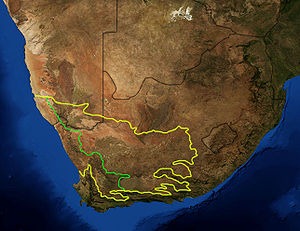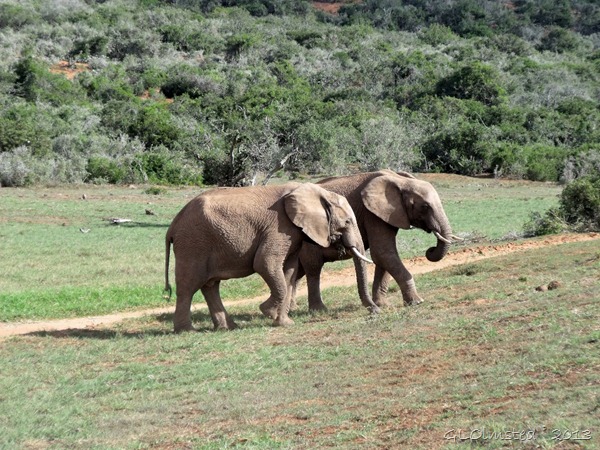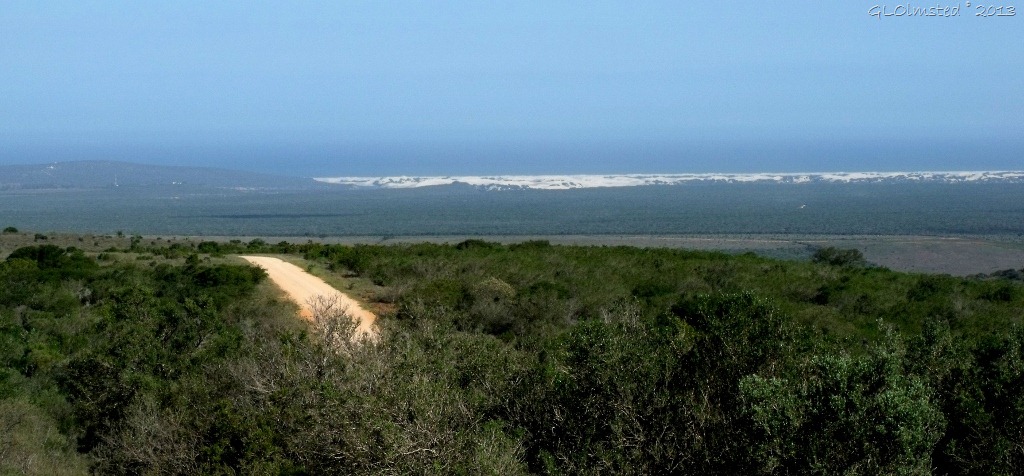Karoo
The Karoo has nothing to do with Kangaroo. It’s a huge portion of central and western South Africa known as the Karoo, a semi-desert region with two main sub-regions—the Great Karoo in the north and the Little Karoo in the south. The western section is the Succulent Karoo, situated in a winter rainfall region near the Atlantic coast. I’ll be traveling through the more desert-like Little, or Klein Karoo.
Western and eastern Karoo from NASA
Yes, I’m still researching places I want to visit in South Africa. Once I’m done exploring Golden Gate Highlands National Park the journey south towards the coast crosses at least 375 miles (600k) of the Karoo.
At one time large herds of antelope, zebra and other large game roamed the grassy flats. But with the occupation by European settlers in the mid-1700s, sheep gradually replaced the game and the cover of grass degenerated due to over grazing. Sheep farming is still the economic backbone of the Karoo along with game farms and tourism.
Crossing Great Fish River near the coast
Cradock
The historic town of Cradock, called the Heartland of the Karoo, sits on the banks of the Great Fish River and is a chief center for South Africa’s wool industry. Although I’ll be here during summer it couldn’t hurt to plan ahead for cold spring and fall at the Grand Canyon and find some angora fleece woven into socks, blankets and beanies. Plus word is that “foodies” are crazy about the Karoo mutton because of the special flavor from the sheep grazing on herbed bushes. Pre-spiced might be nice.
And just north of town the Cradock Spa offers sulfur baths (temp 38°C (100°F) used for the treatment of rheumatism. Might just be a good place to camp and soak for a night, if it’s not too hot outside.
Mountain Zebra
Just west of Cradock, Mountain Zebra National Park works to save the dwindling Cape mountain zebra population. The park boasts a conservation success story protecting over 700 zebra as well as wildlife such as endangered black rhino and cheetah. These zebra differ from the Burchell’s zebra I’ll see in Kruger National Park by having narrower stripes, absence of shadow stripes and orange facial coloration.
Addo
I can’t quite wrap my head around where the southern edge of the Karoo lies, maybe right before the coast. But Addo Elephant National Park stretches from the semi-arid karoo in the north, over the Zuurberg Mountains, through the Sundays River valley and south to the Indian Ocean. This much biodiversity within about 60 miles (96k) drive even at a slow-poke park crawl must be like watching a fast forward movie. Of course I don’t want to hurry through and miss anything. In fact I can see spending a couple days here.
The original elephant section of the park was proclaimed in 1931, when only sixteen elephants remained in the area. Today the park provides sanctuary to over 550 elephants plus lions, buffalo, black rhino, spotted hyena, leopard, a variety of antelope and zebra species, as well as the unique Addo flightless dung beetle. I know you’re waiting with held breath for photos of them all and especially that beetle.
Looking out on the Indian Ocean from Addo
As far as I can figure looking at various maps the southern entrance/exit of Addo cruises from Karoo to coast and darn near drops into Port Elizabeth. Another spot on my list of places to visit plus meet up with a fellow blogger. Then turn west to Tsitsikamma.
Have you been through the Karoo and have places to suggest that I just shouldn’t miss? I’m into detours.
Capturing the present for future memories of the past
My 1200th post.




